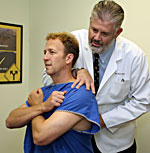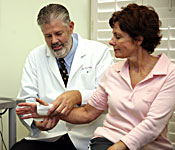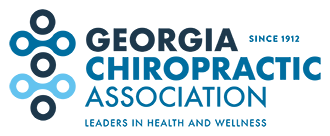Pain Relief
Back Pain Relief
Research shows up to 80% of adults will experience back pain at some point in their life. Mundane activities like bending, lifting, sitting or driving too long, can place severe stress on your back and create problems. Additional factors including sprained ligaments, arthritis, obesity and disease in certain internal organs (like the kidneys) can lead to back pain.
Chiropractors directly relieve back pain through a hands-on spinal manipulation method. The Agency for Health Care Policy and Research, a federal government research organization, recommended spinal manipulation as the only safe and effective, drugless form of initial professional treatment for acute lower back problems in adults. Additionally, chiropractors are trained to provide advice on posture and other preventive activities that can reduce your risk of back pain.
Pain Relief and Management

Pain is disruptive, uncomfortable and part of every day life. Pain management is a $100 billion industry and one of the most common reasons people seek chiropractic treatment.1 Whether you experience pain from the mundane activities of life, repetition or specific accidents, chiropractic aims to alleviate discomfort and restore normal functioning for the body to heal naturally. The following are common conditions people need pain relief and management:
Back Pain Relief: Research shows up to 80% of adults will experience back pain at some point in their life. Mundane activities like bending, lifting, sitting or driving too long, can place severe strain on your back and create problems. Throwing out your back can also be caused by stress. The constant tension in your muscles can turn even the smallest movements into an injury.
Chiropractors are trained to provide advice on posture and other preventive activities that can reduce your risk of back pain. Chiropractors can also directly relieve back pain through a hands-on spinal manipulation method. The Agency for Health Care Policy and Research, a federal government research organization, recommended spinal manipulation as the only safe and effective, drugless form of initial professional treatment for acute lower back problems in adults. Additionally , research found that chiropractic treatment of acute low back pain was relieved 94% in 14 days vs. 25% relief from conventional care.2
Neck Pain Relief: The neck is not an uncommon source for pain. It serves many important functions to our body in that it controls the movements of the head and supports its weight, as well as it contains the majority of the nerves that connect from your brain to the rest of the body. Whether from injury and whiplash or everyday activities, chiropractors can help lessen the pain and nerve irritation through hands-on treatment to the head, neck, shoulders, and arms. The overall patient satisfaction rate for chiropractic treatment on neck pain is 94%.3
Joint Relief: As we get older, our joints and muscles deteriorate from the routine activities of life. Our bodies try to adjust and minimize the pain by joints laying down extra bone, but a worn joint can cause strain and inflammation on the nerves. The stiffness and inflammation resulting from wear and tear is arthritis, spondylitis or rheumatism. This pain can affect any joint in your body, but chiropractic care can often help reduce and manage the pain.
Spinal Relief: The spinal cord is an integral part of the central nervous system, which sends messages from your brain to the body. Due to the nature of life, the spine can experience a loss of its normal movements and alignment, which prevents the whole body from working properly.
Chiropractors focus on identifying and treating the misalignment that could be causing other joint malfunctions. Several techniques are utilized for spinal treatment including spinal manipulation, massages, physiotherapy exercises and recommendations for lifestyle and wellness changes.
Headaches & Migraine Relief: Headaches are a sign from our body that something is wrong. Tension in the neck joints and muscles often contribute to your head pain.
Chiropractors can identify and treat the stress in your neck, shoulders and back. This can alleviate the stress and irritation on the nerves, and may be an effective treatment to minimize the frequency and severity of headaches and migraines.
Sciatica: Sciatica (also called radiating/ referred pain, neuropathy or neuralgia) causes symptoms including numbness, muscle weakness and dull aching or extreme pain. The pain can be masked by many symptoms and is generally located in the back of one of the patient’s legs, as well as possibly going through the lower back and buttocks.
A chiropractic treatment plan for sciatica is individualized for each patient, but may include ice/cold therapy and manual manipulation of the spine. In certain cases, the chiropractor may believe the symptoms of the sciatica are too severe and refer the patient to another professional in the medical field for further treatment. For severe cases, surgery may be recommended.
Herniated discs: When the soft material of a disc (cartilage between the individual vertebrae of your spine) is torn and inflamed, it might bulge out from in between the vertebrae and is said to be herniated.
Chiropractor treatment can help restore normal spinal alignment and allow the body to naturally function properly .
Scoliosis: Scoliosis is an abnormal curvature of the spine. The condition is more common among females than in males, and typically is observed during the pre-teen and early teenage years.
Chiropractic care offers a safe, non-surgical treatment that may not cure scoliosis, but offers relief with some of the symptoms, along with easing any pain or discomfort associated with scoliosis.
Joint problems (i.e. shoulder pain, tennis elbow, et cetera): A chiropractor can treat many joint problems, including arthritis, through the use of many different treatment options, including manual spinal manipulation and various physiotherapy treatments.

Carpal Tunnel Syndrome (C.T.S.): C.T.S. is a problem associated with the median nerve, which runs from the forearm to the hand. It is typically a result of engaging in repetitive motions, such as typing. Patients suffering from C.T.S. report that they experience burning, tingling, or itching sensations in their hands. Office workers are the stereotypical sufferers of CTS.
Chiropractors can recommend several different treatment options for C.T.S., including rest and avoiding any repetitive activities that can aggravate the symptoms. A wrist brace may also be worn to keep the wrist stable.
Stress: Copious amounts of chronic stress are taxing on the body and mind. It is related to cancer and can lead to inactivity, problems with finances, family, depression, obsessive and/or compulsive behavior, and even possibly suicide. Stress is both a physical and mental response to the difference between our expectations and our personal experience. In small doses stress is not necessarily a bad thing, as it can spur us to do our best such as the feeling of nervousness before giving a big speech, or the adrenaline rush before skydiving, but the management of your stress is key.
Chiropractors can help alleviate the muscle tension and headaches brought on by stress. It is thought that helping with the physical problems will assist in the mental condition.
The American Chiropractic Association (ACA) recommends patients pursue stress relief in a variety of ways, including eating a healthful diet, building a strong support system of friends and family, getting enough sleep and exercising on a regular basis. Other methods of relief include music therapy, aromatherapy and journaling.
|







